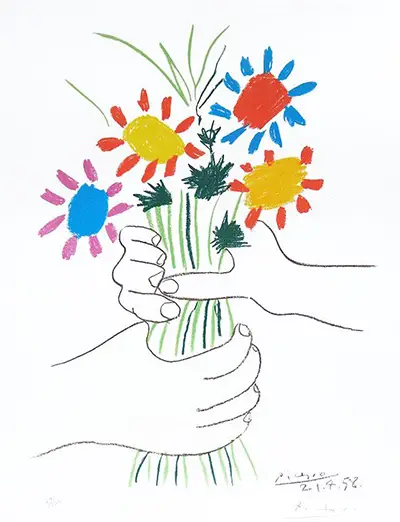Picasso was renowned for his style diversity and in Mains aux Fleurs (Hands with Flowers); he chose to keep it simple.
The colour painting consists of two hands holding blue, yellow, red and orange flower stalks. Picasso hand-signed his name and date (21.4.58) with a pencil on the piece at the right and bottom corner.
Picasso created the Bouquet of Peace in July 1958 to commemorate the peace demonstration held in Stockholm, Sweden. The original was a watercolour lithograph printed by Schuster, Paris.
This painting is made up of four large flowers and three smaller ones. Picasso used oval shapes to depict the centre of the big flowers. Spectators will also notice the oval shapes used for the fingernails.
The artist doesn’t attempt to make the flowers look real. However, the bright colours attract from a distance away. The mixture of lively primary colours and brilliant shades of secondary colours make the painting hard to pass by. Picasso uses thin lines for the stems, which render sharp contrasts to the flower petals and the hands holding them.
Advocating for Peace
As an older man, Picasso became a vocal advocate for peace and did other paintings such as the Dove of Peace to showcase his commitment.
He also joined the Peace Movement, and his Dove of Peace became the symbol for the group. Picasso believed in promoting harmony among all people, which is what the two hands holding the flowers symbolise.
The hands in the Mains aux Fleurs are of two different individuals because they are both right hands, although that fact may not be apparent at first glance.
Picasso painted chunky hands that grip the flowers tightly. Various interpretations come from the gesture of two people holding a bouquet of flowers. One person may be passing it to the other or two individuals may just be holding the bouquet symbolically.
Whichever the case, the Hands with Flowers represent sharing, love and friendship. Flowers have always had a positive feeling attached to them.
They are used to show gratitude, love and joy, among other sentiments. By drawing the painting for the peace movement in Sweden, Picasso was encouraging people to stay good to one another even with the turmoil going on at the time. The two hands signify brotherhood and unity while the flowers evoke cheerful emotions from spectators. Its white background allows the loud colours of the flower petals to jump out of the painting.
Pablo Ruiz Picasso is credited as one of the greatest artists of the 20th Century. He began creating masterpieces even before he was 10 and his collections constitute some of the most creative artwork of his generation. Born in Malaga Spain, the painter, ceramist and sculptor evolved his style incredibly over the years. He was a well-known rebel and shunned any rules in both his artistic and real life that he deemed restrictive. Picasso is the father of cubism, a style of painting that assembles characters using geometric forms.
He later moved from cubism and ventured into child-like paintings, which is the category where the Bouquet of Peace falls. This piece conveys the innocence that is typically present in children’s paintings. The flowers are painted the same way children paint the sun- a circle with rays sprouting from the centre. He painted the hands using simple lines curved in the right places while the stems are just strips of blue lines. Picasso always wanted to portray the playfulness of children and their perception of the world, especially after he became a father. The simplicity of the piece adds to the purity of the message, which is what the artist aimed to achieve with his works.
Picasso witnessed the horrors of World War II and other unrests of the period that inspired him to speak out against the inhumanity of it all. One of his greatest anti-war pieces is Guernica, created during the Spanish Civil War in 1937. It was after WWII that the artist became political and joined the Communist Movement. Most of Picasso’s artwork during this time focused on sending messages of peace to the world even though they did not gain as much popularity as his earlier pieces. Although the Dove of Peace is more recognisable with the peace movement, the Bouquet of Flowers did as much to symbolise the struggle for global unity.


